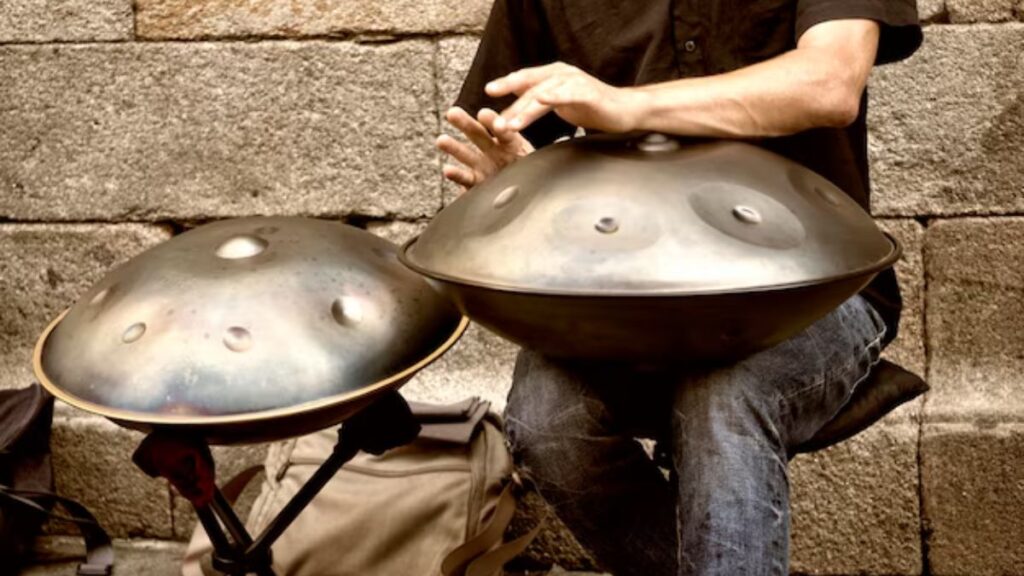A handpan drum is perhaps the most unique of all musical instruments in the world—with its amazing harmonies and straight-up heavenly sounds and timbre. Not only is it easy to learn how to play these musical devices, but they also steal the hearts of everyone who hears the sounds they make.
But if you are new on this journey to figuring out handpans, you must be wondering how to keep your handpan musically in tune. Fear not, young musicians—this guide will dive into just that.
We will equip you with just the right amount of knowledge needed to help you protect and save the vibrant spirit of your handpan. Our step-by-step process will allow you to get to know the mysteries of handpan drum tuning.
Grasping The Basics
A typical handpan is made up of two steel hemispheres hammered into a dome, with the tone fields hammered onto its surface. Each tone field produces a unique, foundational main note, alongside rich overtones of harmonics, which are usually an octave and a fifth. This layered toning is what gives these hang instruments their phenomenal, warm, and immersive sounds.
However, over time, with regular use of these drums, some of these notes can go a little out of tune. When this happens, you need to retune the devices a bit to bring back their original state and recover their full sonic harmony.
What You Need to Tune a Handpan
- Tuner: You would need a chromatic tuner or a tuning app that will read the exact frequency of the notes.
- Rubber Mallet: Carries out fine adjustments without denting the metal.
- Tuning Fork: Handy for establishing a reference pitch—however, it is up to you if you want to use it.
- Ball Bearings: Useful to change the pitch of specific notes.
- Tweezers: These put the ball bearings in place and remove them from where they should be removed.
- Tuning Stick: A small tool to hold a tone field steady or gently tap it while you make adjustments.
Keeping Your Handpan in Harmony
Oh, that feeling when your new handpan drum’s tunes form the most enhanced melody! It’s otherworldly. It’s phenomenal. However, over weeks of basking in the glory of your hang drum, small dents or string tensions can arise and distort the beautiful, harmonic sound of your musical device.
Luckily, learning some basic, run-of-the-mill tuning practices will help you restore the magic and clarity of your handpan drum. This best beginner’s handpan guide will teach you how to catch on to the signs that your instrument needs tuning— as well as equip you with the techniques needed to safely make adjustments in the pitch and prevent early detuning by carefully maintaining the hang drum.
Continue reading to keep your hang drum sounding like its best self for years!
The Step-By-Step Process to Follow
1. Check the Current Tuning
Before you delve into retuning your handpan drum, you need to assess whether the tuning is actually off. Start by holding onto your chromatic tuner or a tuning app—and then play each note on your drum very slowly and carefully. This will help you check the pitch of the drum against the tuner. Close your eyes. Listen very, very closely. Take note of which notes sound a little unruly. Are they too sharp? Too flat?
This assessment will help you realize exactly where the adjustments are needed.
2. Prepare Your Workspace
Take yourself to a place where you are comfortable, and at peace. Somewhere quiet, where you will not be disturbed. Make sure you have all your tuning equipment with you—rubber mallet, ball bearings, tweezers, and your tuner. Keep them out where they can easily be reached by you when you need them. Quickly dust away your handpan to clean it of any dust or debris which might interfere with your ability to tune. A clear surface means you will have better contact and more consistent results.
3. Fixing the Notes
For notes that are too high, or too sharp, you need to use the rubber mallet to lightly knock around the outer edge of the note’s tone field to ‘lower’ its pitch. This will loosen the tension of the note. Keep in mind that you have to be incredibly gentle with your taps—as too much force can damage the note.
For notes that are too flat, or too low—it’s time to bring out the ball bearing. As you softly play the note, keep the ball bearing on the tone field and carefully, slowly roll it outward from the centre of the note. This practice adds a little pressure, which allows you to ‘raise’ the pitch of your hang instrument. Keep doing this until the tuner assesses that the note is back in tune.
Admittedly, these techniques require a ton of patience—but they are quite simple to learn and very effective.
4. Fine-Tuning
After making these adjustments, give your musical device a break to rest for a while. After a few minutes, you can reassess the notes with a tuner and repeat the necessary adjustments. Make sure you do not overtune a note in one session.
5. Final Testing
Once all of these steps are complete and your notes are perfectly settled, play them one by one to check out the harmony. Allow your hang drum to rest for a couple of days before making additional changes, if necessary.
One thing to remember: Handpan tuning is a careful and gradual art, and trying to get it done faster may do more harm than good.
Why Choose Drums From Cosmos Handpan
If you are on the lookout for handpans on sale, Cosmos Handpan has one of the best collections on the internet. These collections feature some of the best beginners’ handpans, handcrafted using stainless steel. The Cosmos Handpan website also offers some advice on how to choose the best handpan that fits your needs. Our team offers guides, playing tips, and video demos to assist you in starting your musical journey with just the right instruments.
Conclusion
Honestly, tuning your handpan may seem scary at first—you do not want to mess up, and you might be intimidated by the number of steps needed to get it working perfectly again. But rest assured, with just a little bit of practice, you will have mastered these tips and techniques perfectly.
Think of assessing the tune of your hang instruments regularly as a rewarding task and not a chore. Retuning your musical devices when needed will help them maintain their harmonic tones and beautiful notes. And all it requires is a bit of patience from your side. This, in turn, helps keep the magic of these handpan drums alive for a long, long time.
If you want to read more, visit our blog page. We have more topics!







